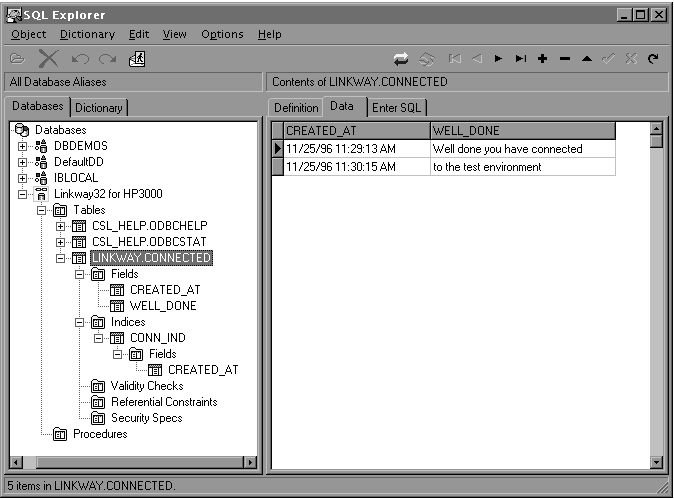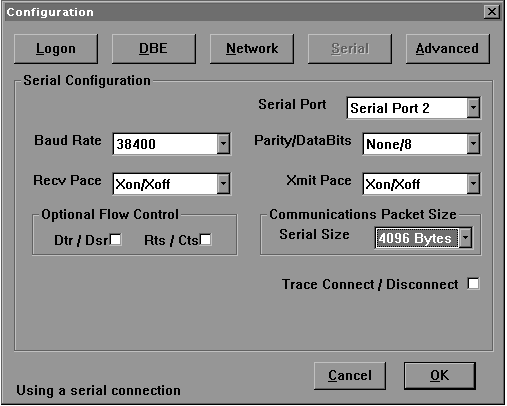

Linkway connects IMAGE
to ODBC clients with robust access
Database middleware offers both
16/32-bit, serial and network
links in standalone product
Review by Shawn M. Gordon
Distributed access to data is a hot topic,
and it’s only getting
hotter. You see distributed applications
and client-server computing
becoming more prevalent, and you want to
get in the game. A good
generic way to leverage your HP 3000 into
this is by using an
ODBC driver. ODBC is a Microsoft brainchild
that stands for Open
DataBase Connectivity. The protocol allows
you to select a driver,
use a generic data access syntax, then read
from and write to
the database at the other end. The trick in
the 3000 market was
getting something to read from and write to
an IMAGE/SQL database.
HP has offered a free 16-bit ODBC driver
for IMAGE/SQL, but never
got around to writing a 32-bit driver. With
the recently-shipped
Express 3 MPE/iX 5.5, HP now offers
ODBCLink/SE. But CSL has been
offering a 16-bit driver since 1995, and a
32-bit driver more
recently. Essentially, CSL’s Linkway
product can take any MS Windows-based
program that supports ODBC such as Word,
Excel, Access or Visual
Basic, for example, and set it up to get
its data straight from
your IMAGE/SQL database.
Linkway’s approach requires some magic
on your end, in much the
same way that ODBCLink/SE does: setting up
the SQL part of IMAGE/SQL
by implementing Allbase database
environments (DBEs) for your
TurboIMAGE data. Some products on the
market that deliver ODBC
connectivity don’t require this step,
like Minisoft’s ODBC/32
and M.B. Foster Associates’
DataExpress.
Unlike ODBCLink/SE and ODBC/32, Linkway
doesn’t rely exclusively
on a TCP/IP connection to the host. Linkway
also supports serial
access, which includes dial-up, as well as
X25 connections.
How does it work?
There are two basic components involved in
Linkway. Server-side
software runs on the HP 3000, a process
typically known as a “listener”
because it listens for client requests. The
client software is
the second component. The CSL ODBC driver
needs to be installed
on each client PC that wishes to take
advantage of the Linkway
driver. It’s this piece of software
that acts as the generic middleware
between the client and the server. Once
these pieces are installed,
a Visual Basic application (for example)
doesn’t need to know
it’s talking to an Image database on a
serial connection – it’s
all handled inside the ODBC driver.
Features
On the server side of the process there are
a number of things
to occupy your time, but let’s talk
about the features. Once your
server is running you have a LINKCTL
utility that allows you to
monitor and manipulate the server process.
Commands for running
its processes are shown in Figure 1.
By building a message file called LINKLOG
in the same group and
account where the Linkway server is
running, you are able to have
a comma-delimited log file generated. Since
the file is comma
delimited, you can import it into any tool
to generate custom
reports. By building a message file named
LINKMON using the same
rules, you get a log of all SQL
information.
Linkway will also tie into Security/3000
from VESOFT if you own
it, to make use of the HELLO procedure
exits. This allows you
to apply the same granular security to the
ODBC connections as
you use with your regular user logons. This
was a nice, unexpected
feature.
Linkway version A.01.00
Computing Solutions Limited
10 St. Andrews Rd
Droitwich, Worcestershire, UK WR9 8DN
Phone 44 1905 794 400
FAX 44 1905 794 464
email: information@csllink.com
Web: www.csllink.com
Linkway includes the 3000-based server
software and the ODBC driver
that is required for the client PCs. It
provides 16- and 32-bit
ODBC driver support from Win 3.1, Win 95,
and Windows NT applications.
Linkway supports serial, remote, and X25
connections in addition
to standard LAN connectivity. Enhanced
security features are supported
through Security/3000 by Vesoft.
Linkway for the HP 3000 runs on all HP 3000 Series 900s, MPE/iX 4.0 or later. The software is tier- and user-based, ranging from $2,500 for 8 users on a 918 to $20,000 for an unlimited license on a 996, with discounts for multiple CPUs. Support is 20 percent of the purchase price per year and includes phone-in and electronic support as well as new releases of the software.

